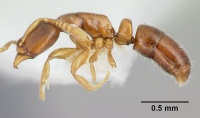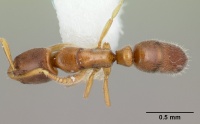Hypoponera dis
| Hypoponera dis | |
|---|---|

| |
| Scientific classification | |
| Kingdom: | Animalia |
| Phylum: | Arthropoda |
| Class: | Insecta |
| Order: | Hymenoptera |
| Family: | Formicidae |
| Subfamily: | Ponerinae |
| Tribe: | Ponerini |
| Genus: | Hypoponera |
| Species: | H. dis |
| Binomial name | |
| Hypoponera dis Bolton & Fisher, 2011 | |
Collections of Hypoponera dis have been made from leaf litter sampling in primary forest.
Identification
A member of the abeillei group. See the nomenclature section below for identification details.
Keys including this Species
Distribution
Latitudinal Distribution Pattern
Latitudinal Range: -5.732599° to -7.89576°.
| North Temperate |
North Subtropical |
Tropical | South Subtropical |
South Temperate |
- Source: AntMaps
Distribution based on Regional Taxon Lists
Afrotropical Region: United Republic of Tanzania.
Distribution based on AntMaps
Distribution based on AntWeb specimens
Check data from AntWeb
Countries Occupied
| Number of countries occupied by this species based on AntWiki Regional Taxon Lists. In general, fewer countries occupied indicates a narrower range, while more countries indicates a more widespread species. |

|
Estimated Abundance
| Relative abundance based on number of AntMaps records per species (this species within the purple bar). Fewer records (to the left) indicates a less abundant/encountered species while more records (to the right) indicates more abundant/encountered species. |

|
Biology
Castes
Nomenclature
The following information is derived from Barry Bolton's Online Catalogue of the Ants of the World.
- dis. Hypoponera dis Bolton & Fisher, 2011: 42, figs. 31-33 (w.) TANZANIA.
Unless otherwise noted the text for the remainder of this section is reported from the publication that includes the original description.
Hypoponera dis resembles Hypoponera aprora in most respects, but differs strikingly because the latter lacks the prora on the first gastral sternite, a structure that is obviously present in dis (as well as in all other known Afrotropical species). In addition, aprora is darker brown and has the anterior and posterior faces of the petiole node less convergent dorsally when viewed in profile. Petiolar indices are also different, compare aprora PeNI 84–87, DPeI 163–173, with the indices for dis, above.
An isolated worker from Tanzania (AFRC, details below) is darker in colour than the type-series of dis, and some of its dimensions and indices (HW 0.42, PrW 0.32, WL 0.72, CI 81, SI 81) are very slightly outside the range of dis, while others are within it. As only a single specimen is known, and its resemblance to dis is so striking, it is retained in that species for the present.
Description
Worker
(holotype in parentheses). Measurements: HL 0.50–0.52 (0.51), HW 0.38–0.40 (0.39), HS 0.440–0.460 (0.450), SL 0.33–0.35 (0.34), PrW 0.29–0.30 (0.29), WL 0.64–0.68 (0.65), HFL 0.32–0.34 (0.33), PeNL 0.15–0.16 (0.15), PeH 0.30–0.32 (0.30), PeNW 0.23–0.24 (0.23), PeS 0.227–0.237 (0.227) (8 measured). Indices: CI 75–78 (76), SI 83–88 (87), PeNI 77–81 (79), LPeI 47–53 (50), DPeI 145–160 (153).
Eyes absent. Apex of scape, when laid straight back from its insertion, distinctly fails to reach the midpoint of the posterior margin in full-face view; SL/HL 0.65–0.67. Cephalic dorsum finely but distinctly reticulate-punctate. Pronotal dorsum almost smooth, with spaced minute, superficial punctures; obviously much less strongly and densely sculptured than cephalic dorsum. Latroventral surfaces of head with spaced minute punctures. Metanotal groove absent on dorsum of mesosoma. Mesonotal-mesopleural suture absent on side of mesosoma. Propodeum angulate between declivity and side. Posterior surface of petiole node without short cuticular ridges that radiate upward from the peduncle. Node of petiole in profile with the anterior and posterior faces somewhat convergent dorsally so that the node is broader just above the tubercle than at its apex. Subpetiolar process with an obtuse ven-tral angle. Maximum width of first gastral tergite in dorsal view distinctly greater than the width of the second gastral tergite at its midlength. Base of cinctus of second gastral tergite glossy and polished, without trace of crossribs. Midline length of second gastral posttergite, from posterior margin of cinctus to apex, is greater than the width of the segment at its midlength. Disc of second gastral tergite with superficial small punctures. First and second gastral tergites dorsally pubescent and with a number of short standing setae that project above the level of the pubescence in profile. Full adult colour light to medium brown.
Type Material
Holotype worker, Tanzania: Pwani Region, Mlolo Forest, Mafia Island, 20 m., 9-13.iii.2008, CEPF-TZ-18.2-F08, 7.89576S, 39.82842E, AFRC-TZ-02, primary forest leaf litter, Winkler (P. Hawkes, Y. Mlacha, F. Ninga) (South African Museum).
Paratypes. 9 workers with same data as holotype; 1 worker with same data but CEPF-TZ-18.2-F71 (SAMC, California Academy of Sciences, Afribugs Collection, Barry Bolton Reference Collection).
References
- Albuquerque, E., Prado, L., Andrade-Silva, J., Siqueira, E., Sampaio, K., Alves, D., Brandão, C., Andrade, P., Feitosa, R., Koch, E., Delabie, J., Fernandes, I., Baccaro, F., Souza, J., Almeida, R., Silva, R. 2021. Ants of the State of Pará, Brazil: a historical and comprehensive dataset of a key biodiversity hotspot in the Amazon Basin. Zootaxa 5001, 1–83 (doi:10.11646/zootaxa.5001.1.1).
- Camargo, K.S. de. 2011. Composicao e diversidade de "Poneromorfas" (Hymenoptera, Formicidae) em duas fitofisionomias de cerrado e padroes de distribuicao de "Poneromorfas", Pseudomyrmecinae e Cephalotini (Myrmicinae) para o Brasil. Thesis, Universidade de Brasilia.
- Dash, S.T. 2011. A taxonomic revision of the New World Hypoponera Santschi, 1938 (Hymenoptera: Formicidae). Ph.D. thesis, University of Texas, El Paso.
- Dash, S.T., Mackay, W.P. 2019. Capitulo 18. Genero Hypoponera. Hormigas de Colombia.
- Feitosa, R.M., Silva, R.R.da, Aguiar, A.P. 2016. Diurnal flight periodicity of a Neotropical ant assemblage (Hymenoptera, Formicidae) in the Atlantic Forest. Revista Brasileira de Entomologia 60, 241–247. (doi:10.1016/j.rbe.2016.05.006).
- Bolton, B., Fisher, B.L. 2011. Taxonomy of Afrotropical and West Palaearctic ants of the ponerine genus Hypoponera Santschi. Zootaxa 2843: 1-118.
- Yanoviak, S.P., Frederick, D.N. 2014. Water surface locomotion in tropical canopy ants. Journal of Experimental Biology 217, 2163–2170 (doi:10.1242/jeb.101600).
References based on Global Ant Biodiversity Informatics
- Bolton B. and B. L. Fisher. 2011. Taxonomy of Afrotropical and West Palaearctic ants of the ponerine genus Hypoponera Santschi (Hymenoptera: Formicidae). Zootaxa 2843: 1-118
- Nousiainen A. 2017. Leaf litter ants in indigenous rainforest and coniferous plantations of the Taita Hills, Kenya. Master Thesis University of Helsinki, 53 pages.


